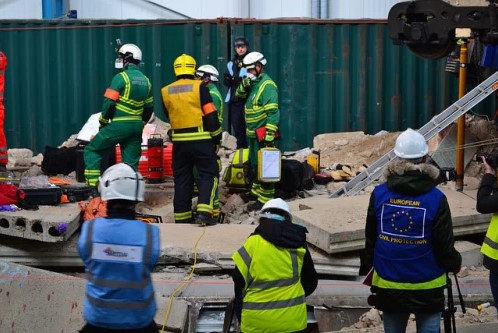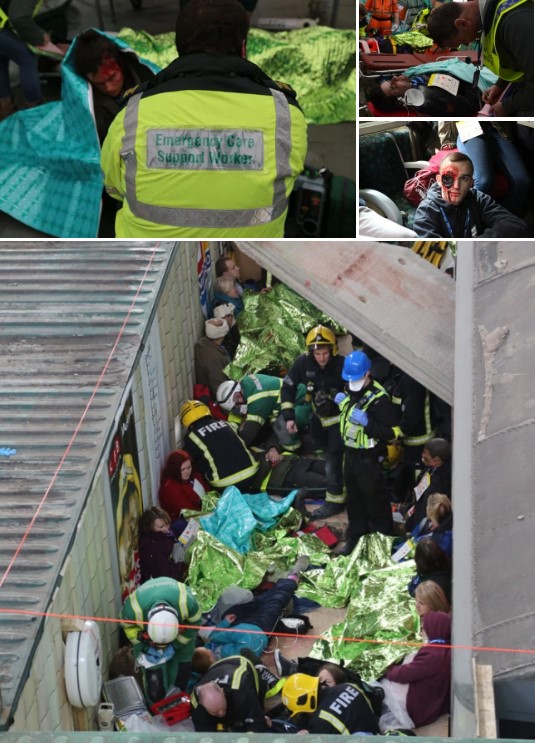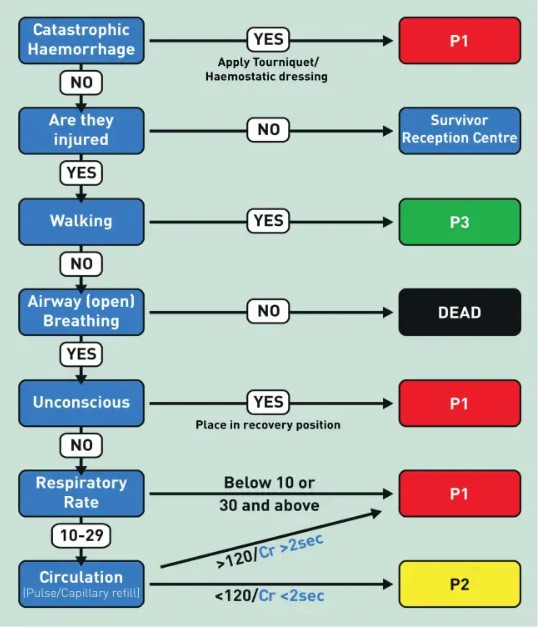Exercise Unified Response – the largest ever disaster exercise in the 150 year history of London Fire Brigade (LFB)
Posted by DS Medical on 2nd Mar 2016
As dawn broke and the sun shone over South East England on the morning of Monday 29th February 2016 the usual calm was shattered. A massive building collapsed on top of London Underground’s Waterloo station. Hundreds were seriously injured, many dead.
Welcome to the start of Exercise Unified Response – the largest ever disaster exercise in the 150 year history of London Fire Brigade (LFB). This four-day exercise organised and operated by LFB, on behalf of London Resilience Partnership took place at the disused Littlebrook Power Station in Kent, England.

The background
Hundreds of emergency service responders from Police, Ambulance and Fire attended daily, alongside specialist rescue teams and crews from Italy, Hungry and Cyprus.
The exercise was designed to test the multi-agency response to a major incident. Although it involved a London-based scenario, the experiences and learning points could be used across the UK and beyond.

On the frontline
Such exercises are essential to ensure emergency services, local authorities and support agencies have the opportunity to test their responses, as London Fire Brigade Commissioner, Rob Dobson, highlights:
'Exercises of this scale are important to ensure that we are always ready to respond no matter what happens. You can’t get this sort of experience from a text book, we need to play it like it’s real and ensure that should the worst happen, our response is effective and well coordinated….’
Commissioner Dobson went on to say:
‘…Exercise Unified Response is not just about the rescues; an incident of this size affects everyone from thousands of stranded commuters who can’t get home, to distraught relatives who can’t reach loved ones. We are working with TfL, local councils and various voluntary organisations to simulate the wider and longer term impacts that any major disaster would have on the community.’
Keeping it real
In order to enhance the exercise hundreds of ‘casualties’ were made up with simulated injuries. Many of these were student paramedics, made up by a team of students studying theatre makeup.
Some examples of what the emergency personnel faced can be seen below. Please note these contain graphic images of simulated injuries which some people may find upsetting.

Triage and scene management
At a major incident, where resources outstrip demand, it is essential that emergency service personnel have a rapid means to manage multiple patients. Triage and scene management are vital tools to achieve this.
Triage sieve is a rapid system of assessing a patient’s condition and places them into one of four universally recognised categories:
- Immediate (P1)
- Urgent (P2)
- Delayed (P3)
- Dead
This process ensures that treatment is provided based on urgency of need; to ensure the highest possible number of survivors within the limit of resources. Triage sieve will often be repeated throughout a major incident, to ensure any improvement/deterioration is accounted for and to maximise the use of the immediately available resources.

Sadly, both deliberate and naturally occurring events across the world regularly mean that emergencies services, allied agencies and many other support networks are regularly faced with mass casualty scenarios. The aftermath of which is felt by all those involved.
Without training scenarios like Exercise Unified Response these groups would not have the opportunity to ensure their skills are at there most effective for when they are needed. Multi-agency working and such large-scale joint exercises are set to be the norm across the UK and EU to ensure the provision of high-quality major incident response.
Exercise Unified Response represents many smaller scale training exercises that are already carried out on a regular basis by local authorities, emergency agencies and hospitals across the UK and Europe. Sharing the lessons learned from these exercises ensures we develop and improve our level of emergency preparedness – making sure we are best prepared for real-life occurrences.
We offer a range of products to specifically support major incident management. If you need further assistance, you can also contact our team on 01329 311451 who will be happy to help.
More information on Exercise Unified Response, multi-agency working and major incident management can be found as follows:
London Fire Brigade
Exercise Unified Response
National Ambulance
Resilience Unit (NARU) – Exercise Unified Response Article
The JESIP programme
and principles
The Daily Telegraph
– Exercise Unified Response in pictures
Daily Mail Online –
Video and images from Exercise Unified Response
Sources and credits:
All photographs are
©2016 London Fire Brigade
Exercise information
courtesy of London Fire Brigade
Triage sieve image
courtesy of National Ambulance Resilience Unit (NARU)
Quotes courtesy of
Daily Mail Online
Infographic ©2016 DS
Medical Ltd


